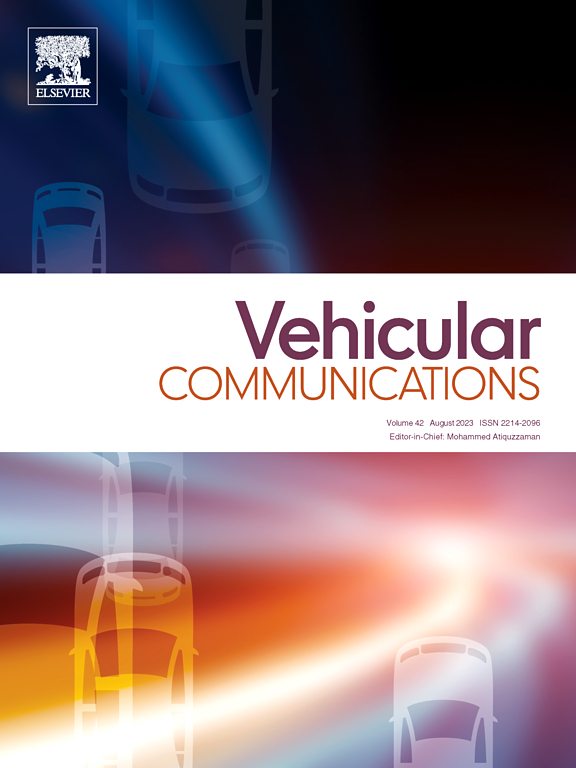在多跳无人机-红外系统网络中使用 M-PSO 实现能效最大化,以改进灾后应急通信服务
IF 6.5
2区 计算机科学
Q1 TELECOMMUNICATIONS
引用次数: 0
摘要
自然灾害往往破坏地面基础设施,导致通信故障,妨碍应急工作。在这些情况下,依赖地面基础设施的解决方案由于位置固定、能源有限和覆盖范围有限而受到严重限制。现有方法往往依赖于地面中继点或固定基础设施,在适应灾区迅速变化的条件方面面临挑战,导致能源消耗无效和通信范围有限。为了应对这一挑战,本工作提出了一种采用无人机(uav)和智能反射表面(IRS)来应对连接挑战并为地面用户(GUs)提供节能通信服务的新方法。提出的框架包括一个多跳通信模型,其中无人机- irs单元作为移动中继,在受影响区域节点和临时基站之间建立强连接。我们提出了一种改进的粒子群优化(M-PSO)技术,该技术可以优化调整无人机的位置和发射功率,同时使用梯度下降(GD)独立优化IRS相移以提高能效。仿真结果表明,我们的设置显著提高了受灾地区的通信能力,在提高覆盖范围和能源效率方面优于传统方法,从而为受灾地区的应急通信提供了一种有弹性的替代方案。本文章由计算机程序翻译,如有差异,请以英文原文为准。
Maximizing the energy efficiency using M-PSO in multi-hop UAV-IRS network for improved post-disaster emergency communication services
Natural disasters often damage the ground infrastructure, leading to communication failures that hamper emergency response efforts. Solutions dependent on ground-based infrastructure suffer from severe limitations in these scenarios owing to fixed positions, limited energy sources, and limited coverage. Existing methodologies, often relying on terrestrial relay points or fixed infrastructure, face challenges in adjusting to rapidly changing conditions in disaster areas, leading to ineffective energy consumption and limited communication range. To address this challenge, this work proposes a novel approach that employs Unmanned Aerial Vehicles (UAVs) alongside Intelligent Reflecting Surface (IRS) to deal with the connectivity challenges and provide energy-efficient communication services for Ground Users (GUs). The proposed framework includes a multi-hop communication model in which UAV-IRS units function as mobile relays, establishing strong connections between the affected area nodes and a temporary base station. We propose a Modified Particle Swarm Optimization (M-PSO) technique that optimally adjusts UAV placement and transmit power while the IRS phase shifts are independently optimized using Gradient Descent (GD) to enhance energy efficiency. Simulation results indicate that our setup significantly enhances communication capabilities in a disaster-stricken region, outperforming conventional methods for enhancing coverage and energy efficiency, thereby providing a resilient alternative for emergency communication in disaster-affected regions.
求助全文
通过发布文献求助,成功后即可免费获取论文全文。
去求助
来源期刊

Vehicular Communications
Engineering-Electrical and Electronic Engineering
CiteScore
12.70
自引率
10.40%
发文量
88
审稿时长
62 days
期刊介绍:
Vehicular communications is a growing area of communications between vehicles and including roadside communication infrastructure. Advances in wireless communications are making possible sharing of information through real time communications between vehicles and infrastructure. This has led to applications to increase safety of vehicles and communication between passengers and the Internet. Standardization efforts on vehicular communication are also underway to make vehicular transportation safer, greener and easier.
The aim of the journal is to publish high quality peer–reviewed papers in the area of vehicular communications. The scope encompasses all types of communications involving vehicles, including vehicle–to–vehicle and vehicle–to–infrastructure. The scope includes (but not limited to) the following topics related to vehicular communications:
Vehicle to vehicle and vehicle to infrastructure communications
Channel modelling, modulating and coding
Congestion Control and scalability issues
Protocol design, testing and verification
Routing in vehicular networks
Security issues and countermeasures
Deployment and field testing
Reducing energy consumption and enhancing safety of vehicles
Wireless in–car networks
Data collection and dissemination methods
Mobility and handover issues
Safety and driver assistance applications
UAV
Underwater communications
Autonomous cooperative driving
Social networks
Internet of vehicles
Standardization of protocols.
 求助内容:
求助内容: 应助结果提醒方式:
应助结果提醒方式:


